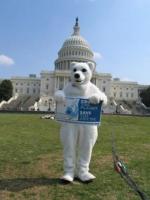“With all of the hysteria, all of the fear, all of the phony science, could it be that man-made global warming is the greatest hoax ever perpetrated on the American people? It sure sounds like it.” – Sen. James Inhofe (R-OK), July 28, 2003.
Few issues in recent memory have riven the body politic as profoundly as climate change. A matter, which, by all accounts, has long been considered fait accompli by the scientific community, has – to the outside world’s great surprise – remained a point of deep ideological dissent within the United States. Opinion polls taken over the past few years have consistently demonstrated a yawning partisan divide over the issue, with Democrats claiming, often by substantial margins, that the effects of climate change have already begun to manifest.
And while the likes of Senator Inhofe certainly exemplify the very worst of climate demagoguery, it is not hard to find others, within government, academic and business circles, who refuse to acknowledge the evidence for man-made climate change – let alone climate change.
In a fascinating article published in the latest issue of Environment Magazine, Riley E. Dunlap and Aaron M. McCright, sociologists from Oklahoma State University and Lyman Briggs College, respectively, explore this phenomenon, its origin and its implications for the 2008 presidential election. They trace the roots of this ideological gap to the early 1980s, when the “Reagan Revolution” ushered in a wave of pro-market, anti-environmental policies that helped lay the ground for the full-blown partisan warfare that would erupt during the second Bush administration.
Up until then, Republicans and Democrats had worked together to enact some of the most significant pieces of environmental legislation – culminating in a series of landmark bills signed into law by President Nixon during the early 1970s – and had enjoyed a shared responsibility for the stewardship of the country’s natural resources. That all began to change once President Reagan took office, bringing a deep-seated distrust of environmental policy and government intervention to his administration.
As Dunlap and McCright note, the divide became particularly noticeable among members of Congress, reaching a new apogee under the tenure of House Speaker Newt Gingrich during the mid-1990s, when he and his colleagues sought to thwart every one of the Clinton administration’s major initiatives.
Clinton’s embrace of the Kyoto Protocol in 1997 was a watershed moment in environmental politicking, prompting Republicans and their conservative allies in the media to angrily denounce climate science and disavow any evidence suggesting the existence of climate change. This marked the beginning of a long period of ideological jousting during which partisan divisions over climate change only seemed to deepen – this despite the fact that a scientific consensus was growing that climate change was man-made and already underway.
Indeed, the results of a Gallup Poll taken over the last decade show that Republicans have become less likely to believe that the effects of climate change are already taking place – shrinking from 48 to 42 percent. On the other hand, the number of Democrats who hold this belief has steadily increased – growing from 52 to 76 percent. While a slim majority of Republicans now say that there is a scientific consensus on climate change, the authors point out that this percentage has remained virtually static during the last 7 years (strangely coinciding with a certain presidency). More worrying are results indicating that the number of Republicans who believe climate change is man-made has dropped 13 percentage points from 2001 to 2008 (53 to 40 percent).
Overall, though the poll findings suggest Americans have become more cognizant of climate change, and generally more concerned about its potential repercussions, they also lay bare the yawning gap that separates Democrats from Republicans on this issue. The more well-informed the respondents professed to be, the more likely they were to have highly divergent views – regardless of their political inclinations. In other words, those who already held firm beliefs about climate change – one way or the other – were more likely to respond in partisan overtones.
Which president is elected in November could mark an important turning point in this debate. While an Obama presidency might further entrench these longstanding divisions, a McCain presidency, the authors argue, could lead to a fundamental rethink of climate and energy policy among Republicans, possibly inaugurating a new era of bipartisan cooperation. Given McCain’s recent selection of Alaska Governor Sarah Palin, an avowed skeptic of man-made climate change and fossil fuel enthusiast, as his running mate (and his own blatant flip-flopping on offshore drilling and other energy-related issues), however, it seems unlikely that his election will do much to change perceptions among the conservative rank-and-file.
Subscribe to our newsletter
Stay up to date with DeSmog news and alerts






